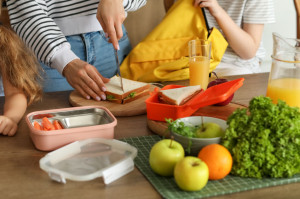 Packing a school lunch that kids will eat rather than trade, ignore, or toss is a challenge many parents face. The balance between offering healthy options and ensuring they’re appealing enough for a child to enjoy is a delicate one. Try these practical tips to ensure your kid’s lunchbox comes home empty.
Packing a school lunch that kids will eat rather than trade, ignore, or toss is a challenge many parents face. The balance between offering healthy options and ensuring they’re appealing enough for a child to enjoy is a delicate one. Try these practical tips to ensure your kid’s lunchbox comes home empty.
Know your audience. First and foremost, understand your child’s taste preferences. While it might be tempting to pack lunches that you’d want, kids often have different tastes. Include them in the decision-making process, and give them a sense of autonomy by allowing them to choose from a list of healthy options. Create a weekly menu together and discuss which fruits, vegetables, and snacks they enjoy. This process not only makes them more likely to eat their lunch but also teaches valuable lessons about balanced eating.
Balance is key. A well-balanced lunch provides the energy and nutrients to keep kids focused and fueled for the rest of the school day. A balanced lunch should have:
- A source of protein (chicken, tofu, beans, nuts, eggs)
- Whole grains (bread, rice, pasta)
- Fruits and vegetables
- A small treat or snack for pleasure—because joy is also a part of healthy eating!
Use creative containers. Lunches can be more fun when they come in exciting packages. Bento boxes and compartment containers are not only visually appealing but help keep foods separate. This is particularly helpful if your child is finicky about different foods touching. Plus, creative presentation—like using cookie cutters for sandwiches or making fruit skewers—can turn an ordinary lunch into a meal they look forward to.
Variety is the spice of life.
Most people don’t like eating the same thing day in and day out. Rotate options regularly and introduce new foods in small, approachable ways. Add a new vegetable along with a familiar favorite, or swap out the type of bread you use for sandwiches. Small changes keep the lunchbox exciting and encourage kids to be open to new foods. Of course, you should refer back to the first tip. If your child insists on eating the same thing every day, pack that food so you know they are eating something. Then add in a small serving of something new.
Make it interactive. Kids love to play with their food, and lunches can be a perfect time for this. Packing items that kids can assemble themselves, like DIY tacos or hummus with veggie sticks, can make lunchtime both fun and engaging. It also encourages them to eat because they’ve had a hand in preparing their meal.
Keep it colorful. A colorful lunch is an eaten lunch. Fruits and veggies add a rainbow of colors to the lunchbox and a wide variety of vitamins and minerals. Plus, they’re more enticing to the eye. Even something as simple as a mix of colorful bell pepper strips can be more appealing than a single color.
Temperature matters. Nobody likes soggy sandwiches or warm yogurt. Use insulated lunch bags with freezer packs to keep items fresh. You can even freeze certain items like yogurt tubes or water bottles, so they double as ice packs and are thawed by lunchtime.
Prep ahead. Mornings can be busy, and when you’re short on time, it becomes tempting to throw in packaged and less nutritious options. Prepping part of the lunches the night before—or making a week’s worth of lunches over the weekend—can relieve the morning stress and help you stick to your lunch goals. Plus, involving your kids in the prep puts them in control and may up the chances they’ll eat what they helped make.
Include a note. Sometimes, all it takes is a little note from home to remind your child of the love that went into making their lunch. A quick “I love you” or a fun riddle can brighten their day and make mealtime special. It’s a simple touch that shows care and can make even an “okay” lunch feel extraordinary.
Every child is different, so what works for one may not work for another. Flexibility, patience, and creativity are key in the lunch-packing game. Remember to keep the lines of communication open; get feedback on what they liked or didn’t enjoy about their lunches to keep improving. With these tips in hand, you’re well on your way to becoming a master of the lunchbox, making meals your kids will look forward to and, most importantly, eat!







